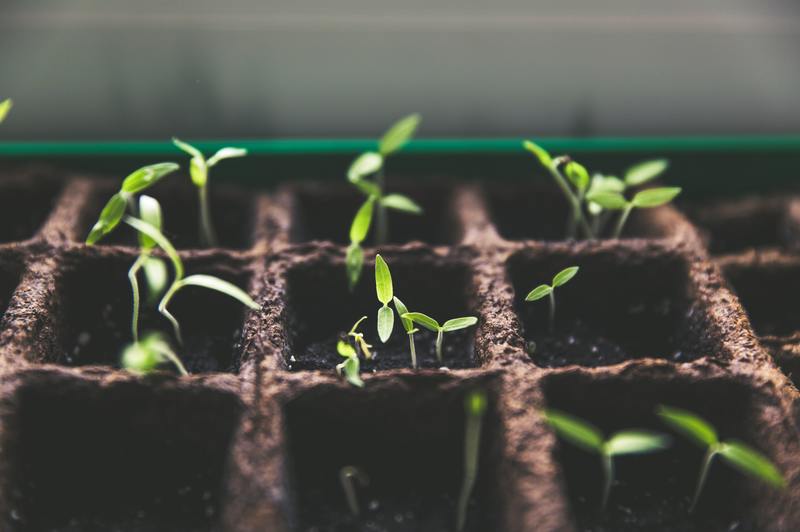Molds are one of the biggest frustrations of homeowners like you, even in plant caring. All you can think of is how to get rid of mold on germinating seeds before the form even endangers your healthy soon-to-be plants.
You don’t have to fret over this issue as molds are, in fact, harmless to your seeds, provided that you take immediate actions as early as you catch them. It’s also a common problem that gardening newbies or even the “expert” ones might encounter.

However, the condition or environment causing the mold growth might be why your growing seedlings have to die out.
Lucky you, since this article can help you get the molds off your seeds in just five easy steps. Plus, we’ll cover some tips for you to prevent mildew from occurring in the first place.
Causes Of Mold Growth On Starting Seeds
Before tackling the steps on mold removal, why don’t we first talk about what causes mold growth on your germinating seeds?
Poor ventilation
The top reason for mold development is the temperature surrounding the seedlings. Poor ventilation or too high heat causes increased humidity in the plot area.
A damp environment enables the molds to thrive, although it’s the same good environment for seeds to grow in.
However, this steamy setting would be a perfect breeding place for different kinds of molds. One of the most common kinds you can encounter is the white fuzzy mold.
Overwatering
The second cause of molded seeds might be the excessive watering of your plants. This repetitive action leaves your seeds soaked in water, thus retaining lots of liquid in the soil.
Overcrowding
Sometimes you tend to overfill the seeds inside the same seedling plot, and once the seeds take roots, congestion happens. This overcrowding causes inadequate airflow, making the sprouts an easy target of fungi.
Here’s another informative article about the causes of white molds on plants that might help you solve other plant mold problems.
Removing Mold On Sprouting Seeds
Now that you know the causes of seed mold let’s hop onto the quick and easy steps to get rid of mildew on your germinating seeds.
Step #1. Prepare tools
You’ll need simple tools to scrape off the molds. You can use a small dagger or a sharp pencil to take the white molds from the soil.
Any fan can also help provide ventilation for the seed and soil. You’ll need this in the following step.
A moisture meter is another helpful tool to check the dampness level of the ground to avoid overwatering.
Step #2. Remove molds using the tool
To start the process, cautiously scrape as much of the molds to reduce the mold count. Then, wipe it on a paper towel and ensure to dispose of it properly.
This step will help you quickly eliminate all the white molds in the soil and the seedlings.
You might also need to get rid of severely infected soil parts. Read on through this article to help you with the proper process of disposing of potting soil.
Step #3. Ventilate pot trays
If you’ve been keeping your lid on top of your seedling trays, it might have contributed to mold growth. Carefully open one end of the cap to let the airflow in your plot.
However, if the seeds have already developed, you can completely take off the cover to allow proper ventilation for the soil and the plant. Use a fan to help with the ventilation.
Step #4. Dry the soil
After opening the lid, let the soil dry a little bit. Ensuring that the soil is evenly moist will help you avoid too much dampness.
Allow the topsoil to parched in between watering, but avoid drying it out completely. Use a moisture meter to inspect the level of wetness before every watering.
Step #5. Close the heat mat
Finally, to dodge too much high heat on your seedlings, turn down any bottom heat once the seeds have already sprouted.
Tips To Prevent Mold Growth And Regrowth On Germinating Seeds
Even if you’ve taken steps to eliminate the molds, they might return to infest your seeds. To avoid this from happening, heed some tips below on caring for germinating seeds.
- Provide good air ventilation by gently running an oscillating fan over the seed plots. However, avoid drying out the soil.
- Besides proper airflow, ensure good light for your plants by placing them in an area without direct contact with sunlight. 12-16 hours of exposure to solid indirect light each day will help the seeds to sprout well.
- Sterilize the seed trays, shovels, and other planting tools before using them. Soak and scrub them in a bleach-water solution.
Hydrogen peroxide can also work as a plant fungicide.
- Pinch and repot the seedlings when the tray becomes crowded to avoid inadequate airflow.
- Consider doing the bottom-watering to allow the roots to absorb the water directly. It avoids overly wetting of the soil surface so molds can’t multiply.
Conclusion
The steps on how to get rid of mold on germinating seeds are perhaps laid-back tasks given that the mold has not caused severe damage yet to your plants.
Remember that besides taking immediate actions, it’s also equally essential to prevent the molds from growing by changing your planting routines. It doesn’t only save you from frustration; you can also avoid the tedious task of mold elimination.
